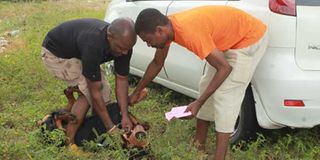Vets in Mombasa vaccinate 3,000 dogs, cats against rabies

Residents of Mombasa a wrestle with a dog after it got loose during celebrations to mark World Rabies Day held in Shanzu on September 28, 2016. Over 3, 000 dogs and cats were vaccinated against rabies. PHOTO | WACHIRA MWANGI | NATION MEDIA GROUP
What you need to know:
- Rabies is a contagious and fatal disease that affects dogs and other mammals.
- Dr Momanyi said that their target is to vaccinate 6,000 dogs and cats against rabies in Mombasa County.
- A report by the Ministry of Agriculture states that 2000 people, mostly children, die every year from rabies.
- Mr Thumbi Mwangi said most of the times, rabies is mistaken for cerebral malaria.
More than 3,000 dogs and cats in Mombasa were Wednesday vaccinated against rabies in a rigorous drive undertaken by the government and the Kenya Veterinary Association (KVA) to prevent the spread of the disease.
The vaccination was done during a free medical camp at Shanzu Prison grounds and also through a door-to-door visits by veterinary officers in Kisauni, Mvita, Changamwe, Jomvu, Nyali and Likoni sub counties.
Rabies is a contagious and fatal disease that affects dogs and other mammals.
It causes madness and convulsions and can be transmitted through the saliva to humans once they have been bitten by rabid dogs or cats.
Doctors said if left untreated, the disease can be fatal.
It is also more expensive to treat in comparison to the costs incurred when animals are vaccinated against it.
RABIES EXPENSIVE TO TREAT
One of the vets, Dr Kelvin Momanyi, said once a person is infected with rabies, treatment costs about Sh10,000 whereas it costs only Sh100 to vaccinate a cat or a dog against the disease.
He said that their target is to vaccinate 6,000 dogs and cats against rabies in Mombasa County.
KVA chairman Samuel Kahariri said the fight against rabies has been complicated by lack of enforcement of laws safeguarding ownership and treatment of animals.
“We have the Rabies Control Act but enforcement has been poor.
“Everyone who owns a dog must take responsibility for their care and treatment,” Dr Kahariri said.
Kenya Medical Research Institute (Kemri) Welcome Trust Fellow Thumbi Mwangi said most of the times, rabies is mistaken for cerebral malaria.
In such cases doctors only discovered much later that a patient had rabies, mostly after deaths have occurred.
A report by the Ministry of Agriculture, Livestock and Fisheries states that 2000 people die every year from rabies, 40 per cent of whom are children.





